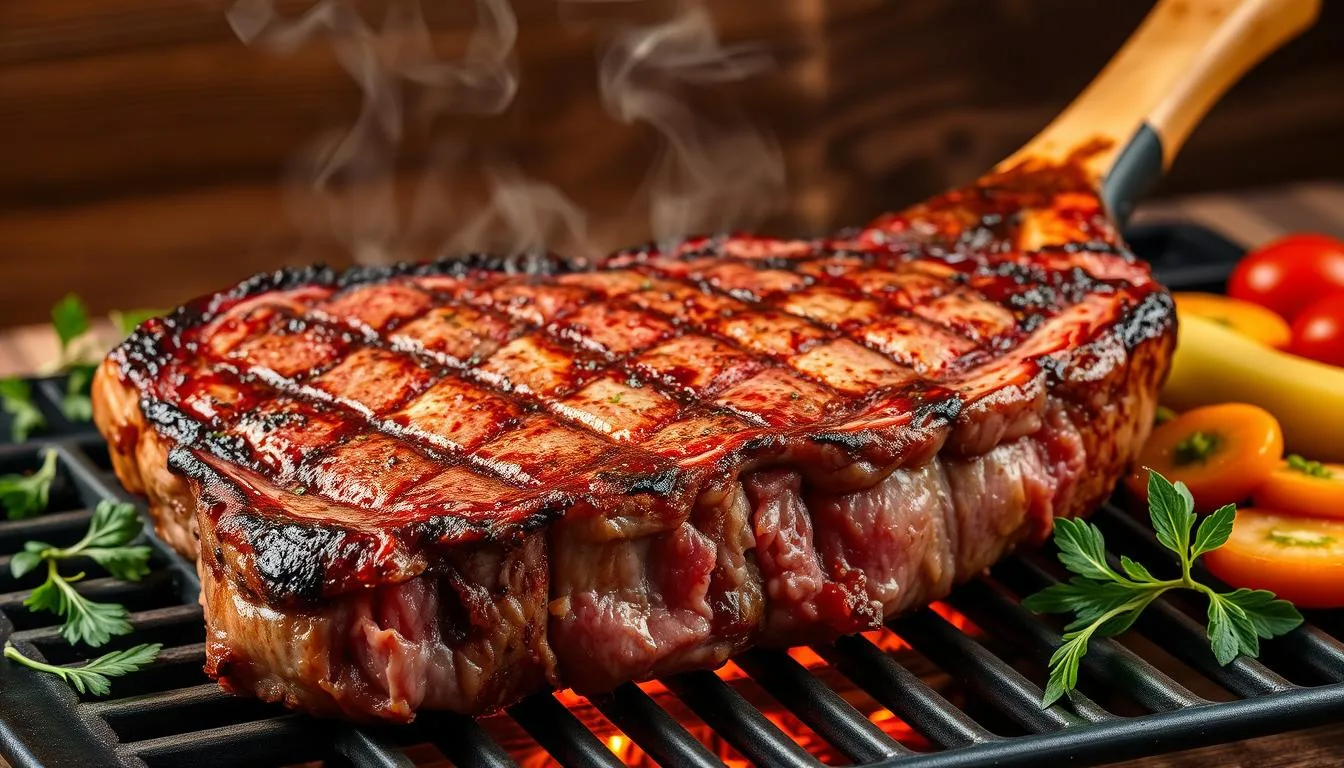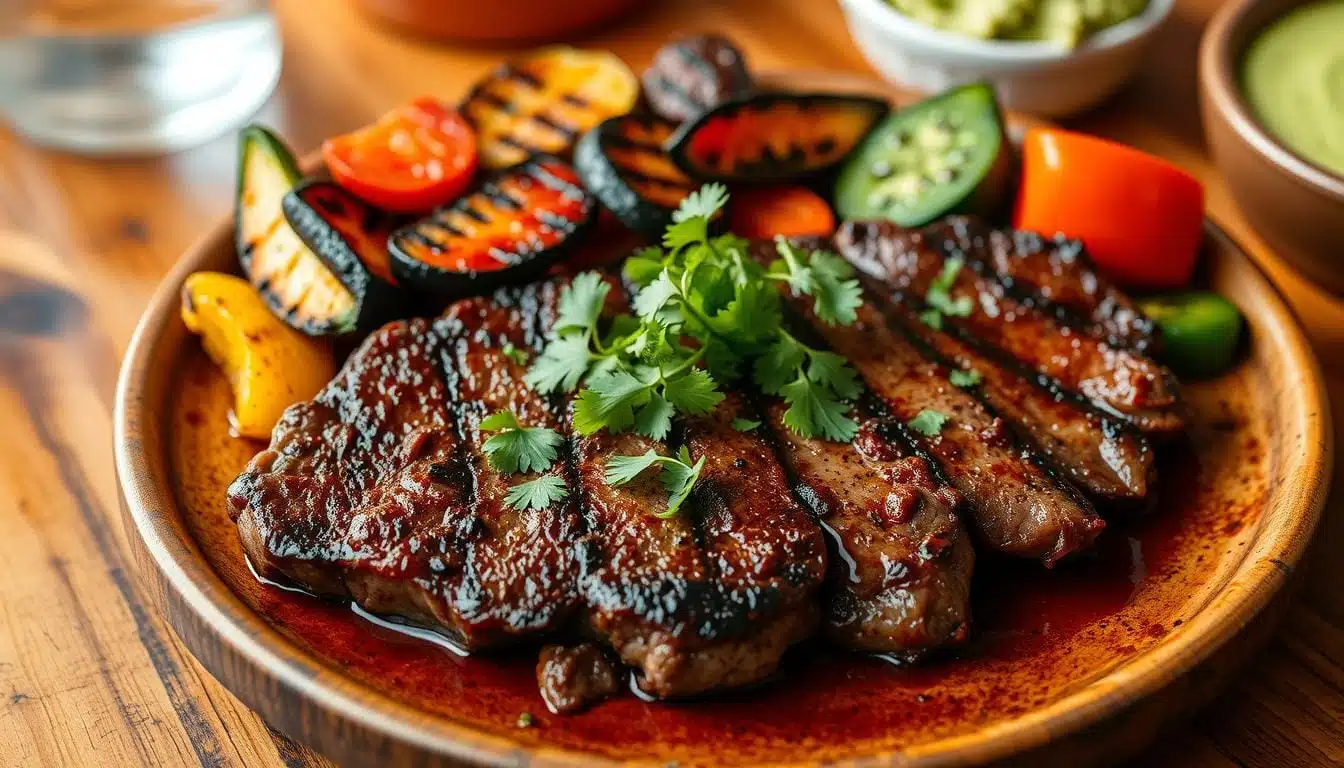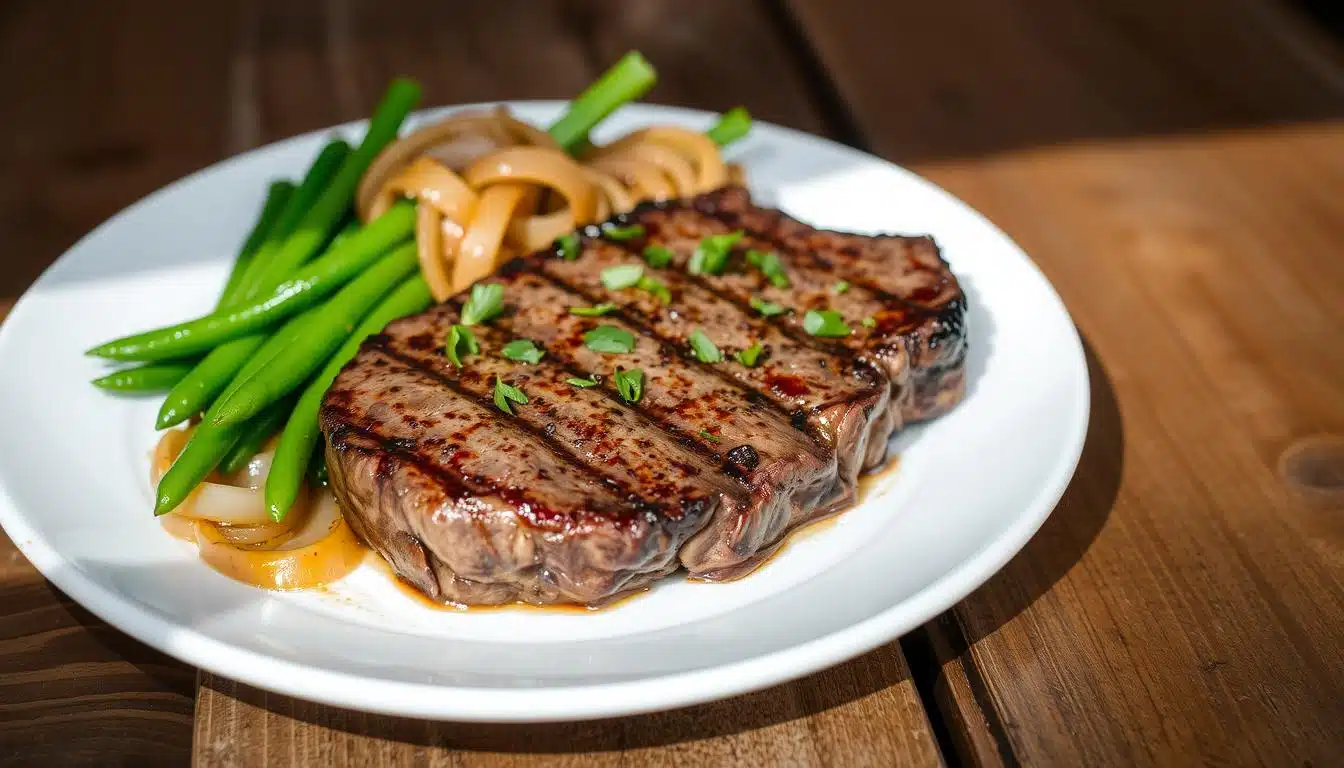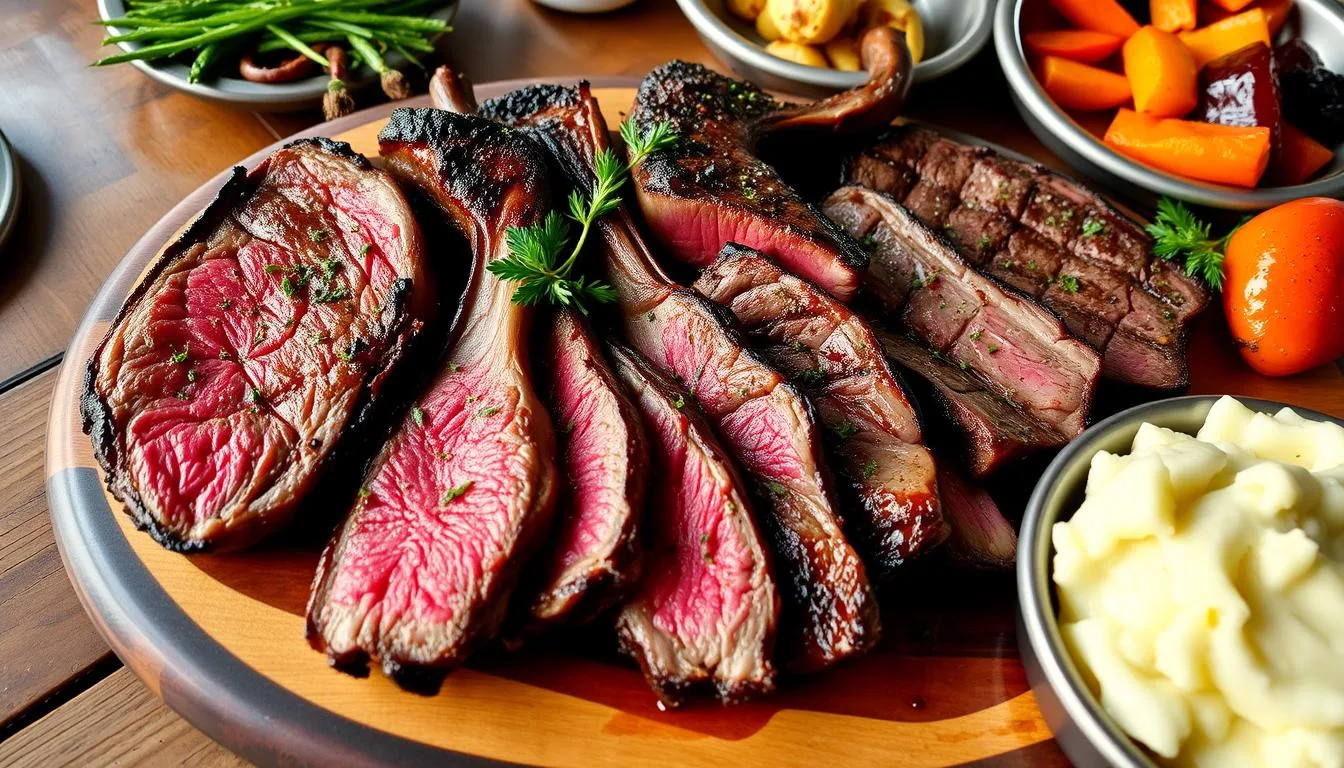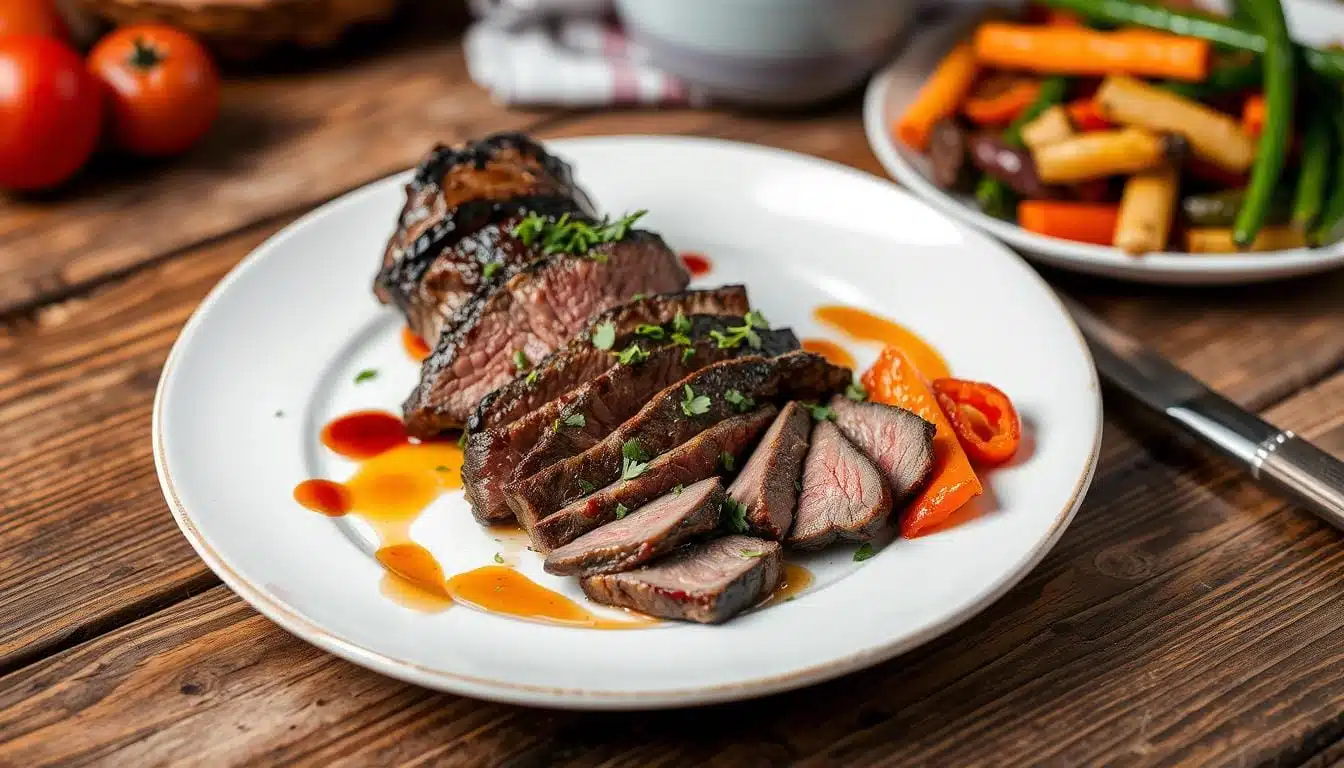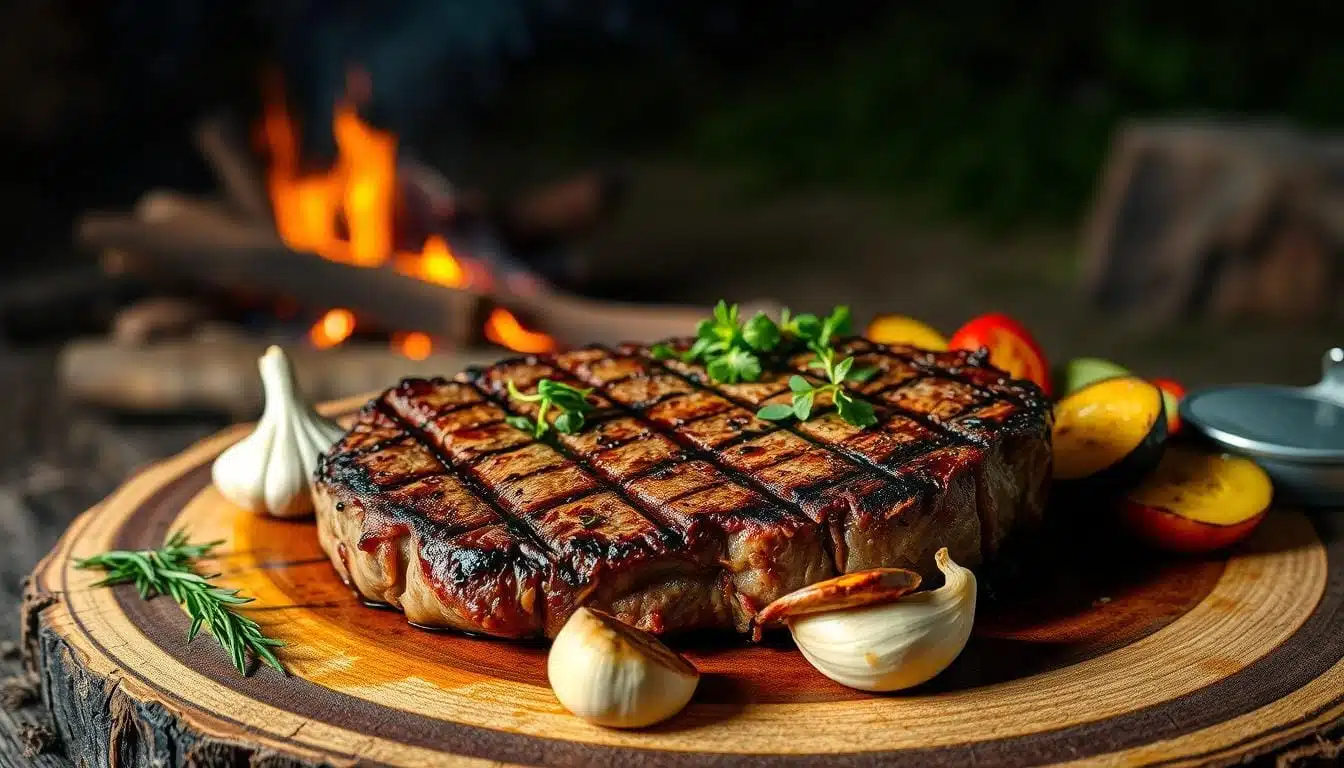Perfect Steak Temps Demystified: How to Get It Just Right
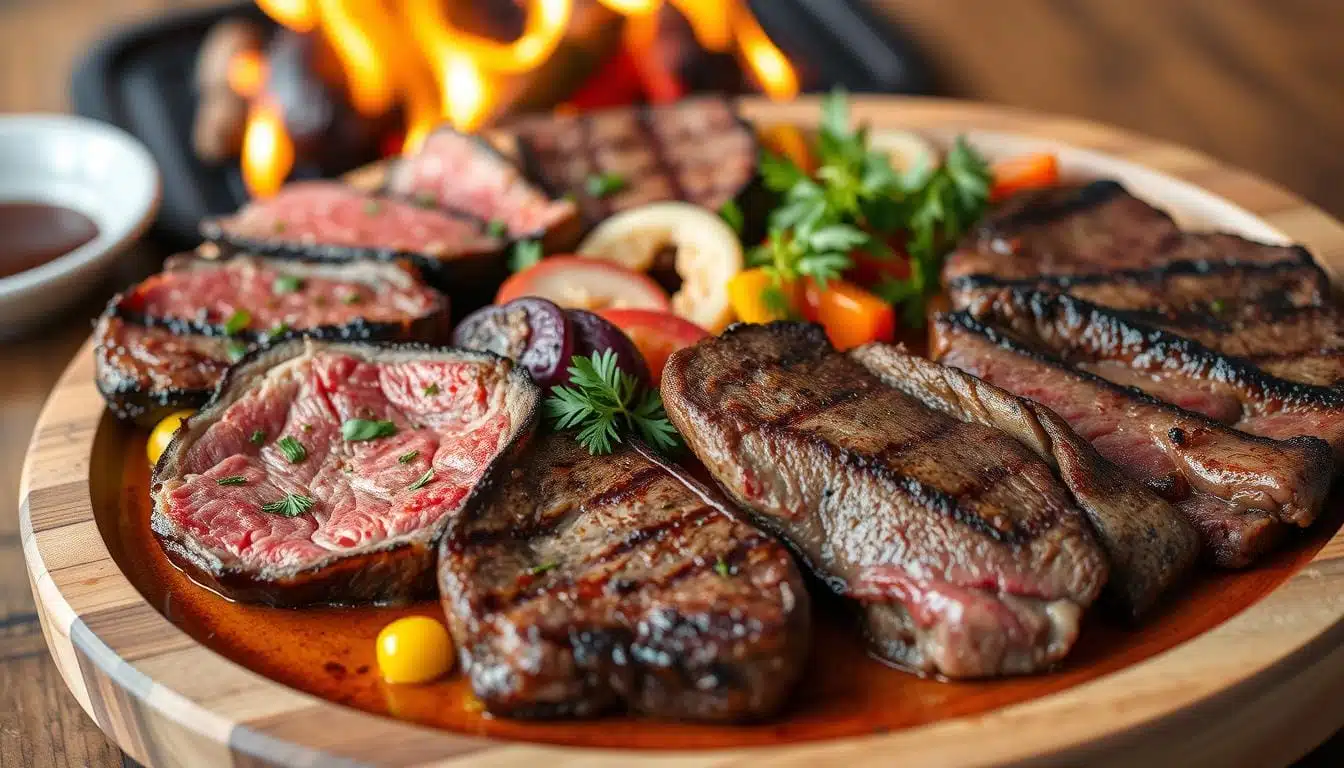
What’s the secret to cooking the perfect steak? It’s all about the internal temperature. This varies from rare at 120-125°F to well-done at 160°F or more. Getting the right steak temps is key to a great meal.
Cooking steak to the right temperature is vital. Whether you like it rare, medium-rare, medium, or well-done, it matters. The USDA says all meat should be cooked to 145°F. Learning about steak temps and doneness levels helps you cook the perfect steak every time.
Table of Contents
The Science Behind Perfect Steak Temperatures
Cooking the perfect steak involves understanding the science behind it. The ideal steak temperature depends on the steak type and desired doneness. For example, a medium rare steak is usually between 130-135°F. This temperature is loved for its tenderness and juiciness.
The secret to perfect steak temperature is knowing how proteins change when cooked. As steak cooks, proteins denature and muscle fibers contract. This affects the meat’s texture and tenderness. That’s why it’s important to follow steak cooking guidelines to get it right.
Several factors influence the perfect steak temperature. These include the steak type, desired doneness, and cooking method. For instance, a thicker steak needs a lower temperature to avoid burning. A thinner steak can handle a higher temperature. The steak type, like ribeye or sirloin, also plays a role in the ideal temperature.
By grasping the science of perfect steak temperatures and following cooking guidelines, home cooks can make steaks as good as those in restaurants. Whether you like your steak rare, medium rare, or well done, the key is to cook it to the right temperature.
Latest Research in Steak Temperature Control
Recent studies show how crucial accurate temperature is in steak cooking. A steak temperature guide is key to getting the perfect doneness. The latest research stresses the need for precise temperature control for the right doneness, whether it’s rare, medium rare, or well done.
A study involved 32 animals, with 16 USDA Select and 16 upper two-thirds USDA Choice carcasses. The steaks were cut into 8 portions each, with two cooking temperatures and two steak thicknesses. Thermocouples were used to monitor the steaks’ internal temperature during cooking.
A steak doneness guide is vital for achieving the perfect doneness. It suggests removing steaks 5-degrees Fahrenheit before the desired temperature. For instance, a medium rare steak should be removed at 125°F. It’s also important to let the steak rest for about 10 minutes after cooking for the best juiciness.
Here is a summary of the recommended internal temperatures for different levels of doneness:
| Level of Doneness | Internal Temperature (°F) |
|---|---|
| Rare | 120-130 |
| Medium Rare | 130-135 |
| Medium | 140-145 |
| Medium Well | 150-155 |
| Well Done | 160-170 |
By using a steak temperature chart and a reliable digital meat thermometer, cooks can achieve the perfect doneness. This ensures a delicious and safe dining experience.
Essential Steak Temp for Every Level of Doneness
Cooking steak to the right doneness is key. Rare steaks are best at 125-130°F, while well-done steaks reach 160°F or more. Knowing the best steak temps is crucial for a pro-like steak.
Medium rare steaks cook between 130°F and 140°F. Medium steaks are 140-150°F. medium steak temps well steaks are 150-160°F, and well-done steaks are over 160°F. A thermometer is the best way to check the steak’s doneness.
| Level of Doneness | Internal Temperature |
|---|---|
| Rare | 125-130°F |
| Medium Rare | 130-140°F |
| Medium | 140-150°F |
| Medium Well | 150-160°F |
| Well Done | 160°F or above |
Follow these steak temps to get your steak just right. Whether you like it rare, medium rare, medium, or well done, use a thermometer. This ensures your steak is cooked to the best temperature.
Modern Temperature Measurement Tools
Cooking the perfect steak needs the right tools. A steak temperature and guide are key. Modern tools make it easier to get the steak just right.
Tools like digital thermometers and probe thermometers give quick, accurate readings. For example, the ThermoPop 2 thermometer can read temperatures in 2 to 3 seconds. The Dot probe thermometer takes 5 to 8 seconds.
When picking a thermometer, look at its accuracy, speed, and how easy it is to use. The ThermoPop 2 is IP67 rated, safe from dust and water. The Dot probe is IP65 rated, safe from dust and water jets.
Also, think about the thermometer’s price. Cheap ones are slow and not accurate. Better ones cost between $30 to $105. Some even come with heat-resistant cables up to 700 °F.
Using a steak temperature chart and guide with modern tools ensures perfect steaks. This improves flavor and texture. It also prevents food-borne illnesses. The CDC says 48 million get sick, 128,000 are hospitalized, and 3,000 die from food-borne diseases each year in the U.S.
The Role of Resting Temperature in Steak Preparation
Resting temperature is key in steak preparation. It lets the meat relax and spread out its juices. After cooking a steak to the right temperature, it’s important to let it rest for a few minutes before cutting it. This step, called carryover cooking, greatly affects the final taste and texture.
Experts say resting a steak for 10 minutes can really improve it. During this time, the outside cools to about 125°F, and the inside to about 120°F. This helps the juices spread out, making the steak more tender and flavorful. This method is crucial for bigger cuts like a whole roasted pork loin or a prime rib.
- Reduced juice loss: By letting the steak rest, the juices are redistributed, resulting in a more tender and flavorful final product.
- Improved texture: Resting a steak allows the muscle fibers to relax, resulting in a more tender and enjoyable texture.
- Enhanced flavors: Resting a steak can help to contain the juices and ensure maximum flavor.
| Steak Type | Recommended Resting Time | Internal Temperature |
|---|---|---|
| Rare | 5-7 minutes | 120°F – 130°F |
| Medium Rare | 7-10 minutes | 130°F – 135°F |
| Medium | 10-12 minutes | 140°F – 145°F |
By following these guidelines and using the best steak temps, home cooks can achieve a perfectly cooked steak with minimal juice loss. Always use a meat thermometer to make sure the steak is safe to eat.
Different Cuts and Their Ideal Cooking Temperatures
When cooking steak, the perfect temperature depends on the cut. Knowing the ideal steak temps for each cut is key. For a rare steak, aim for 120–129°F (49–54°C). Medium rare should be between 130–134°F (54–57°C).
Here’s a table showing the best internal temperatures for various steak cuts:
| Cut of Steak | Ideal Internal Temperature |
|---|---|
| Rare | 120–129°F (49–54°C) |
| Medium Rare | 130–134°F (54–57°C) |
| Medium | 135–144°F (57–62°C) |
| Medium-Well | 145–154°F (63–68°C) |
| Well Done | 155°F+ (69°C+) |
Popular steak cuts include ribeye, sirloin, and filet mignon. Each has its own best cooking steak temperature. By knowing these, you can cook your steak just right and enjoy a tasty meal.
Common Temperature-Taking Mistakes to Avoid
Getting the perfect steak is all about temperature control. A steak temperature chart is key to getting it just right. But, even with the right tools, mistakes can happen. It’s important to avoid errors when taking the steak’s temperature.
A steak doneness guide helps you know the perfect internal temperatures. Rare steaks should be at 120°F (49°C), while medium steaks should be at 140°F (60°C). To get accurate readings, use a reliable meat thermometer and follow the right technique.
Proper Thermometer Placement
It’s crucial to put the thermometer in the thickest part of the meat. This avoids undercooking. Start checking the meat’s internal temperature 10-15 minutes before it’s done. This lets you adjust the cooking time if needed.
Temperature Reading Errors
Choosing the right thermometer is key to avoid mistakes. Instant-read thermometers give accurate readings in 5 to 10 seconds. Always sanitize the thermometer probe between uses to prevent contamination and ensure accuracy.
Timing Miscalculations
Remembering carryover cooking is important for the perfect steak. Take the meat off the heat 5 to 10 degrees before your target temperature. By following these tips and using a reliable steak doneness guide, you’ll get a perfectly cooked steak every time.
| Level of Doneness | Internal Temperature |
|---|---|
| Rare | 120°F (49°C) |
| Medium | 140°F (60°C) |
| Well-Done | 160°F (71°C) |
How Thickness Affects Internal Steak Temps
Thickness is key when cooking the perfect steak. Thicker steaks need longer cooking times and higher temperatures. Research shows that thicker steaks should be cooked on lower heat to cook evenly.
When cooking thicker steaks, the cooking steak temperature matters a lot. Cook them on low heat at about 250 degrees F for about 25 minutes. Then, sear them to get a perfect crust. Letting the steak rest for a few minutes after cooking helps keep it juicy and tender.
Here are some tips for cooking thicker steaks:
- Cook on lower heat to avoid burning the outside before the inside is done.
- Use a thermometer to check the internal steak temps.
- Let the steak rest for a few minutes after cooking to keep it juicy and tender.
By following these tips, you can get the perfect doneness and enjoy a delicious, tender steak. Always check the internal temperature of the steak, especially for thicker cuts. This ensures food safety and the best flavor and texture.
Restaurant Secrets for Consistent Steak Temperatures
To get a perfectly cooked steak, it’s key to follow certain guidelines and hit the right temperature. Chefs Kevin B. Thomson and Steve Doucakis from top steakhouses in Bangkok share their secrets. They talk about professional kitchen techniques and how to control temperatures.
Chef Thomson says grilling is the best steak how to cook way . It’s important to keep the grill’s temperature just right to avoid burning or sooting. He suggests different cooking times for each level of doneness, from blue (1 min per side) to well-done (4-5 mins per side). Chef Doucakis stresses the need for preheating to get the Maillard Reaction and grill marks.
Professional Kitchen Techniques
Professional chefs use a few key techniques:
- Using a cast iron pan for home cooking steaks for better searing and caramelization
- Resting the meat post-cooking to retain the juices and flavors of the steak
- Controlling the temperature to achieve the perfect level of doneness, whether it’s rare (120-125°F), medium-rare (130-135°F), or well-done (160-165°F and above)
- steak to medium
By following these guidelines and using the right temperatures, home cooks can make steaks as good as those in restaurants. Always focus on temperature control and resting time for a delicious and tender steak.
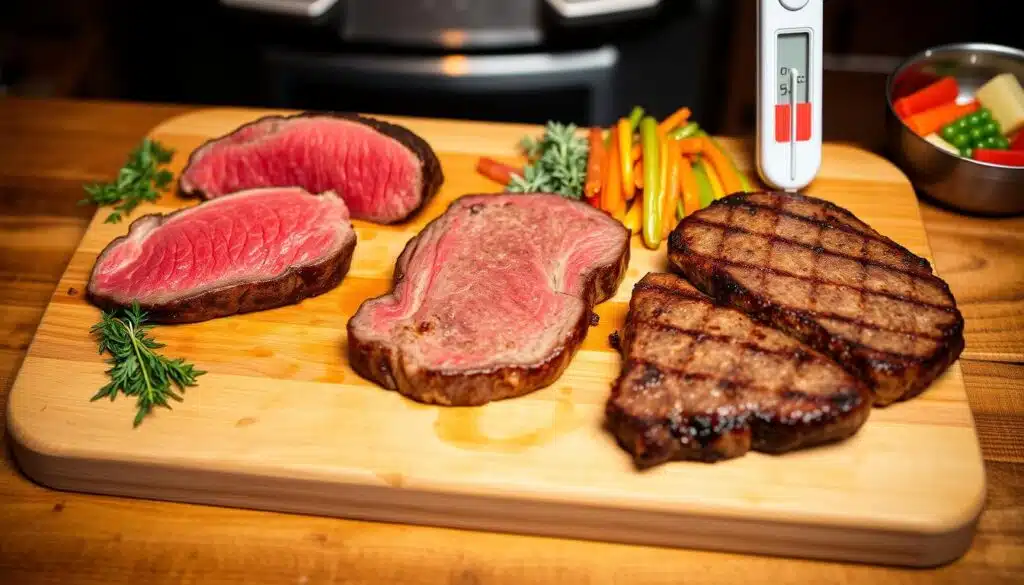
The Impact of Starting Temperature on Cooking
Starting temperature is key when cooking steak. Higher temperatures mean faster cooking, which is great for getting the perfect doneness. But, knowing how starting temperature affects cooking is important for the best results.
The right starting temperature depends on how done you like your steak. For a rare steak, start with 100°F to 110°F. For medium or well-done, start with 120°F to 130°F. Cooking steak temperature control is key to getting it just right.
Here are some important points about starting temperature and steak temps:
- Lower temperatures cook slower, keeping the steak moist and tender.
- Higher temperatures cook faster, creating a crispy crust and juicy inside.
- The starting temperature also affects the Maillard reaction, which adds flavor and browning.
Knowing how starting temperature affects cooking is crucial for a perfect steak. By controlling the starting temperature and cooking steak temperature, you can get a delicious, tender steak that’s just right.
Altitude and Its Effect on Steak Cooking Temps
When cooking steak at high altitudes, it’s key to think about how altitude changes cooking times. At heights over 3,000 ft (900 m), the air pressure drops. This change affects the boiling point of water and how long it takes to cook steak. A steak temperature chart helps figure out the best internal temperature for steak at various altitudes.
To cook steak well at high altitudes, lower the frying temperature by about 3°F (1°C) for every 1,000 ft (300 meters) up. Also, a steak doneness guide offers crucial info on the perfect internal temperature for different levels of doneness.
- Water and other liquids evaporate faster at high altitudes.
- The boiling point of water decreases with elevation.
- Meats cooked by simmering or braising may require 25% more cooking time at 5,000 feet than at sea level.
| Altitude | Boiling Point of Water |
|---|---|
| Sea Level | 212°F (100°C) |
| 2,000 ft. (600 m) | 208°F (98°C) |
| 5,000 ft. (1,500 m) | 203°F (95°C) |
| 7,500 ft. (2,300 m) | 198°F (92°C) |
| 10,000 ft. (3,000 m) | 193°F (90°C) |
By grasping how altitude affects steak cooking temps, you can use a steak temperature chart and a steak doneness guide. This way, you can cook steak perfectly at any height.
Special Considerations for Different Cooking Methods
Cooking steak can vary a lot depending on the method. Grilling, pan-searing, and oven roasting each need their own approach. To get the best results, it’s key to know the specific guidelines for each method.
Grilling adds smoky flavors and sears the steak fast. Oven cooking is great for slow-cooking, making the steak tender. Searing on the grill creates a crispy crust, while basting keeps the steak moist and flavorful.
Here are some key considerations for different cooking methods:
- Grilling: Preheat the grill to high heat, and cook for 4-6 minutes per side, or until the steak reaches the desired internal temperature.
- Pan-searing: Heat a skillet over medium-high heat, add oil, and cook for 3-5 minutes per side, or until the steak reaches the desired internal temperature.
- Oven roasting: Preheat the oven to 425°F (220°C), and cook for 10-15 minutes, or until the steak reaches the desired internal temperature.
By following these guidelines and using the right temperatures for each method, you’ll get a perfectly cooked steak every time. Always use a meat thermometer to check the steak’s internal temperature.
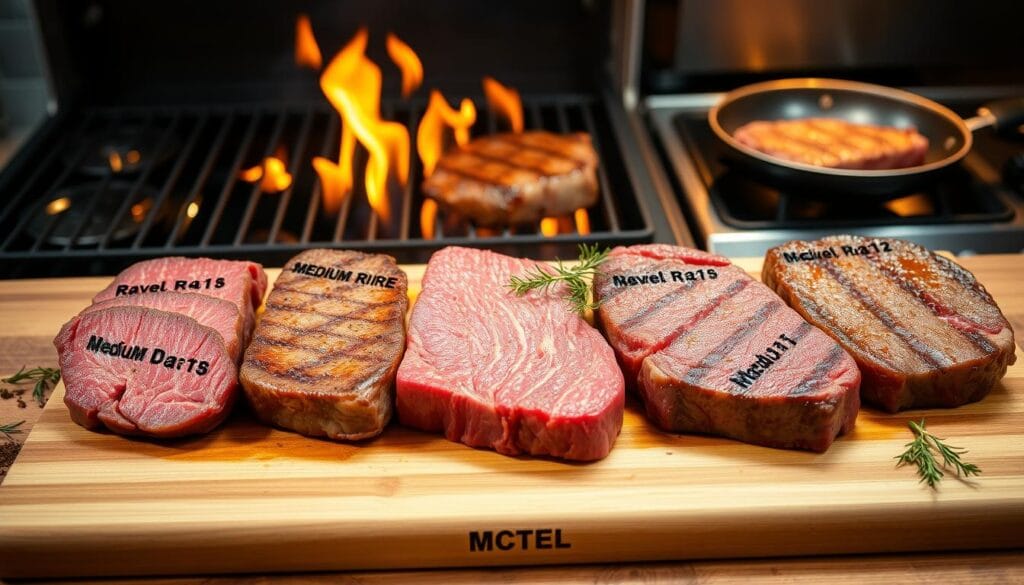
Here is a summary of the recommended internal temperatures for different levels of doneness:
| Level of Doneness | Internal Temperature |
|---|---|
| Rare | 120°F – 125°F (49°C – 52°C) |
| Medium Rare | 130°F – 135°F (54°C – 57°C) |
| Medium | 140°F – 145°F (60°C – 63°C) |
| Medium Well | 150°F – 155°F (66°C – 68°C) |
| Well Done | 160°F and above (71°C and above) |
Temperature Safety Guidelines for Beef
Cooking steak right is key for taste and safety. The U.S. Department of Agriculture sets guidelines for safe beef temperatures. Beef, lamb, and pork need to be cooked to at least 145 F. Ground meat should hit 160 F.
Using a food thermometer is the best way to check steak’s internal temperature. For fresh beef, like steaks and roasts, the safe temperature is between 145 degrees F for medium rare and 170 degrees F for well done. It’s also important to keep refrigerated food at 40 F or below and frozen food at 0 F or lower.
Key Food Safety Principles
- Reheat foods to a minimum internal temperature of 165 F or until they are steaming hot.
- Leftover food that won’t be eaten within about three days should be frozen.
- Food should not be left out of the refrigerator for more than 2 hours, or 1 hour if the temperature is above 90 F.
Following these guidelines helps ensure your steak is both tasty and safe. Always prioritize food safety and handle steak with care for a great dining experience.
Environmental Factors Affecting Steak Temperature
When cooking the perfect steak, many things matter. Temperature and humidity are especially important. A steak temperature chart helps find the best cooking temperature. A steak doneness guide ensures your steak is cooked just right.
Humidity affects how long and at what temperature you need to cook your steak. High humidity means longer cooking times. Low humidity means quicker cooking. Knowing this can make you a steak-cooking pro, impressing everyone with your skills.
Here are some key environmental factors to consider when cooking steak:
- Temperature: The ideal temperature for cooking steak is between 130°F and 140°F for medium-rare, and 140°F and 150°F for medium.
- Humidity: High humidity can lead to a longer cooking time, while low humidity can result in a shorter cooking time.
- Air circulation: Good air circulation can help to cook the steak evenly and prevent it from becoming too dry.
In conclusion, factors like temperature, humidity, and air circulation greatly affect steak cooking. By understanding these and using a steak temperature chart and guide, you can cook steak perfectly. This will make you a pro at cooking steak.
| Environmental Factor | Impact on Steak Cooking |
|---|---|
| Temperature | Affects cooking time and level of doneness |
| Humidity | Impacts cooking time and can lead to dryness or overcooking |
| Air circulation | Helps to cook steak evenly and prevent dryness |
Conclusion: Mastering the Art of Steak Temperature
Mastering steak temperature is key to perfect doneness every time. You’ve learned about heat, protein changes, and muscle density. This knowledge helps you cook steak just right.
Whether you like your steak rare (120-125°F), medium rare (130-135°F), medium (140-145°F), medium well (150-160°F), or well done (over 160°F), this guide has you covered. It teaches you how to be a pro at steak temps and cooking steak temperature. Always use a meat thermometer and rest your steak for the best results.
With patience and practice, you’ll impress everyone with your steak temps and cooking skills. Enjoy the journey of mastering steak temperature and relish every perfectly cooked bite.
How done is a steak at 145?
Medium.
Should steak be at 350 or 400?
400 degrees Fahrenheit.
Is 135 okay for steak?
135 degrees Fahrenheit is the recommended medium-rare doneness for steak.
What is the 3-3-3 rule for steaks?
The 3-3-3 rule for steaks is: 3 minutes sear one side, 3 minutes sear the other side, 3 minutes rest.
